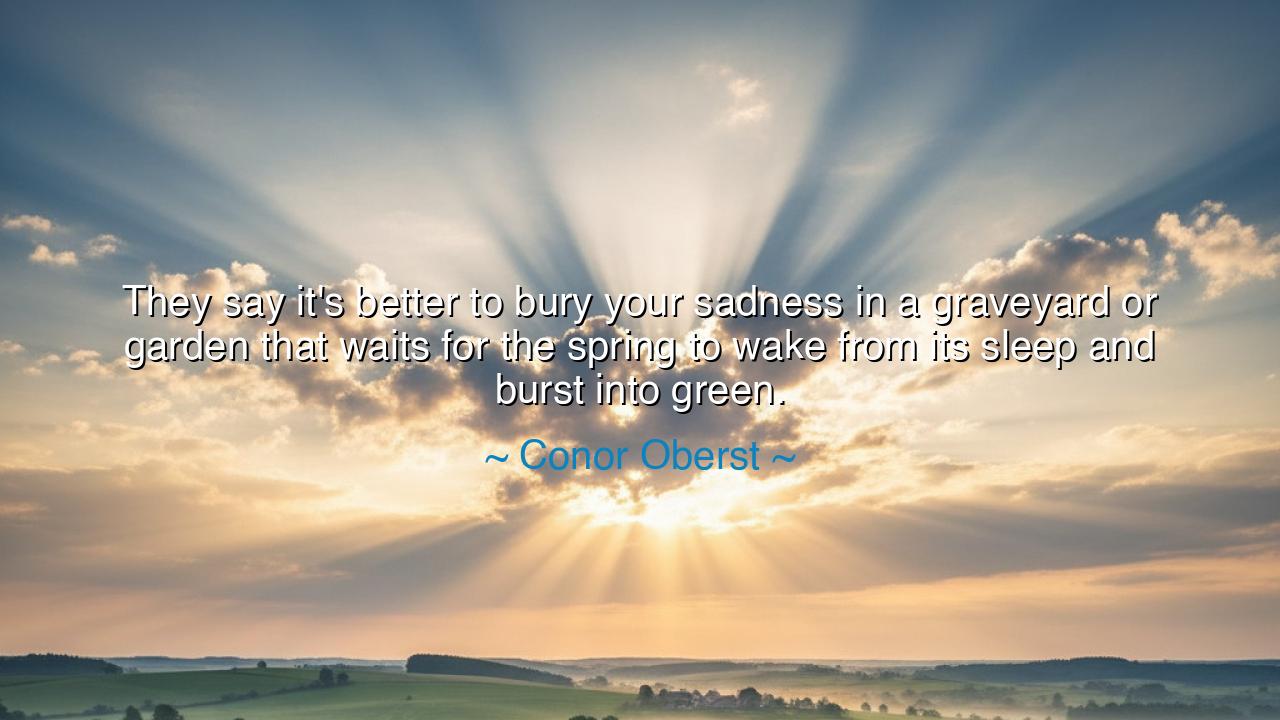
They say it's better to bury your sadness in a graveyard or
They say it's better to bury your sadness in a graveyard or garden that waits for the spring to wake from its sleep and burst into green.






“They say it's better to bury your sadness in a graveyard or garden that waits for the spring to wake from its sleep and burst into green.” — so wrote Conor Oberst, the poet-musician whose words carry the aching pulse of youth and the quiet wisdom of the old soul. This line, born from the heart of a songwriter, speaks of sorrow not as an enemy to be destroyed, but as a seed to be planted, transformed by time and patience into something living and new. Beneath its lyrical surface lies an ancient truth — that grief, when buried in the right soil, can one day bloom into understanding, compassion, and strength.
The ancients would have understood this wisdom well. The Greeks taught that Persephone, goddess of spring, must first descend into the underworld of death before she could bring life back to the world. In that myth lies the same truth Oberst conveys: sorrow and renewal are bound together. The “graveyard” and the “garden” are not opposites, but two faces of one eternal cycle. To bury sadness in the ground is not to deny it, but to give it back to the earth — to let the natural rhythm of existence transform despair into growth. For what is the soil itself, if not the resting place of what once was alive? And yet from that death, life always rises again.
Oberst’s metaphor of the garden waiting for spring also speaks to the discipline of patience. In times of sorrow, the human heart longs for immediate healing, yet the world teaches us otherwise. The soil does not rush the seed; the winter does not hurry the sun. The heart, too, must rest and recover in its season. By burying our sadness — by acknowledging it, laying it to rest, and letting it be — we allow time to do what force cannot: to turn pain into wisdom, and loss into beauty. The “burst into green” is not the forgetting of sorrow, but its transformation into new life.
Consider the life of Helen Keller, who as a child was struck blind and deaf, locked in a silence that could have crushed her spirit. For years she lived in darkness, unable to express her sorrow, until the gentle patience of Anne Sullivan reached her. Through education and time, Helen’s suffering, buried deep within her, began to bloom. Her pain became compassion; her silence became a voice for millions. Like Oberst’s garden, her soul endured its winter and emerged into the eternal spring of service and hope. Her life proves that even the deepest grief can, with patience and love, become the seed of greatness.
In Oberst’s words, the graveyard represents acceptance — the willingness to face what has been lost and to give it a place of rest. Too often, people carry their sadness within them like an unburied ghost, haunting every step they take. But grief, if buried with reverence, can bring peace. The garden, in turn, symbolizes hope — the faith that what seems gone forever may return in another form. For just as flowers grow from the compost of decay, so too does wisdom grow from suffering. The one who learns to plant their sadness instead of denying it becomes like a gardener of the soul, cultivating strength where once there was only sorrow.
Yet Oberst’s quote also carries a warning: do not bury your sorrow in bitterness or denial, for such soil bears no fruit. Only in acceptance — in the soft earth of understanding — can sadness be reborn into something good. The ancients knew this as the art of alchemy: transforming base metals into gold, or in the language of the spirit, turning grief into grace. To bury your pain in the garden is to practice this spiritual alchemy — to trust that your suffering, if tended gently, will one day rise as compassion for others, as humility, as gratitude for the light that follows the dark.
So, my child, when sorrow comes to you — as it surely will — do not flee from it, and do not cling to it. Bury it. Give it back to the earth that made you. Whisper your pain into the soil, and let time and patience tend it in your absence. Do not dig it up too soon, nor forget where you laid it; for one day, when the season is right, you will see it again — not as grief, but as growth. And when that green shoots forth from the ground of your heart, you will know what Conor Oberst meant: that sadness, when given to life rather than fought against it, becomes the very root from which joy is born anew.






AAdministratorAdministrator
Welcome, honored guests. Please leave a comment, we will respond soon